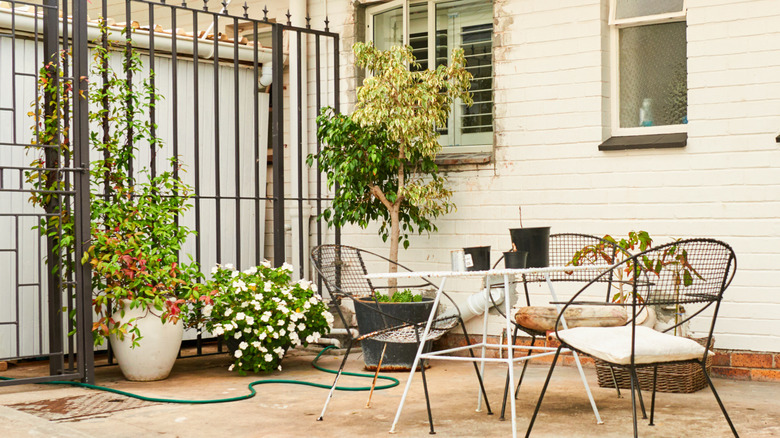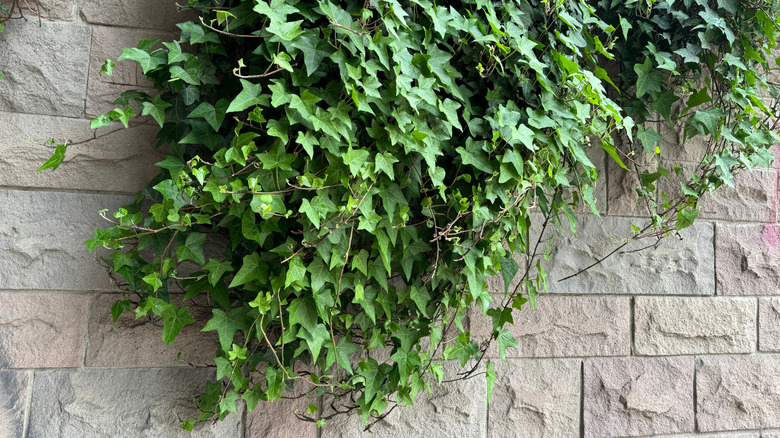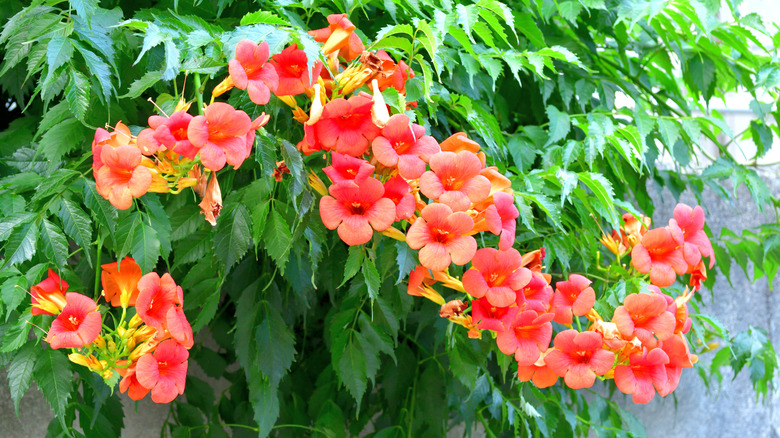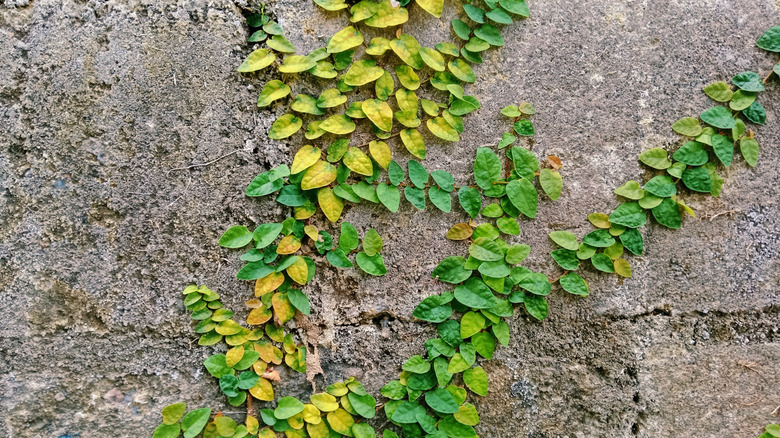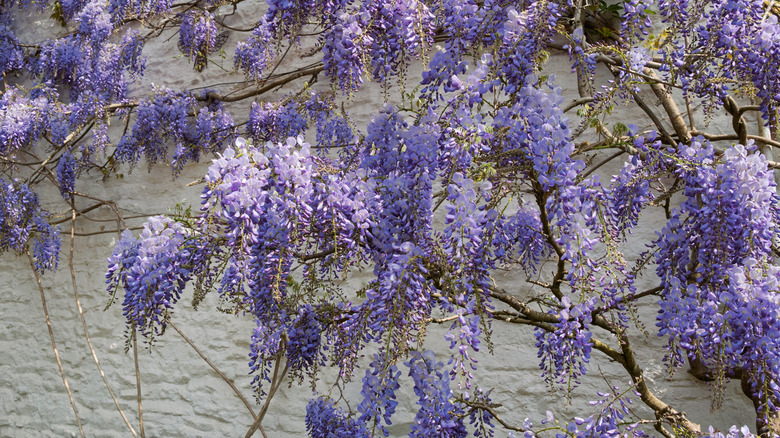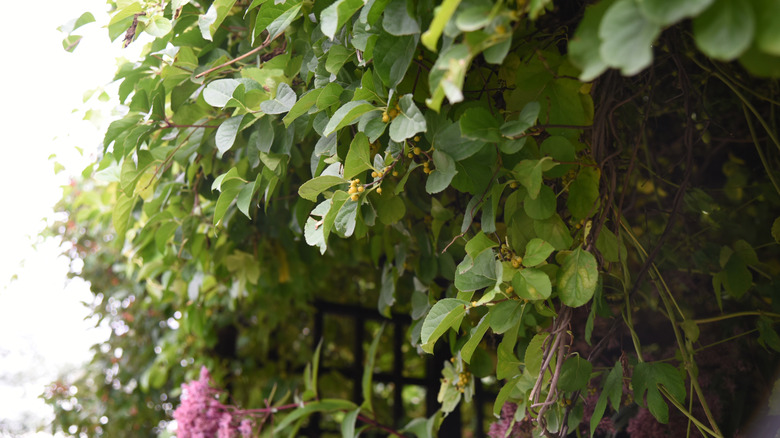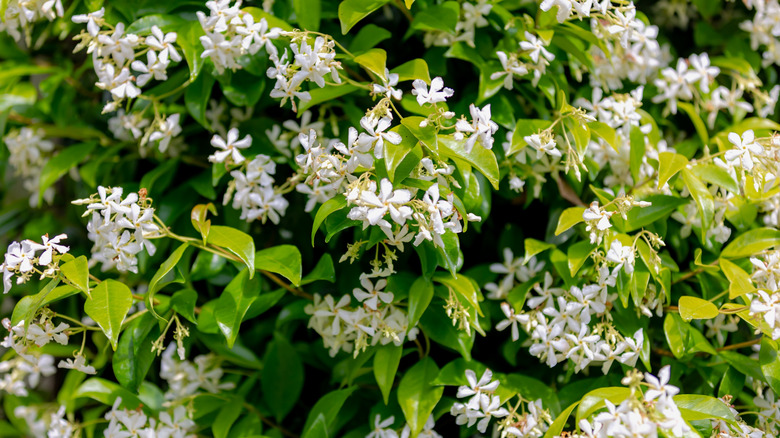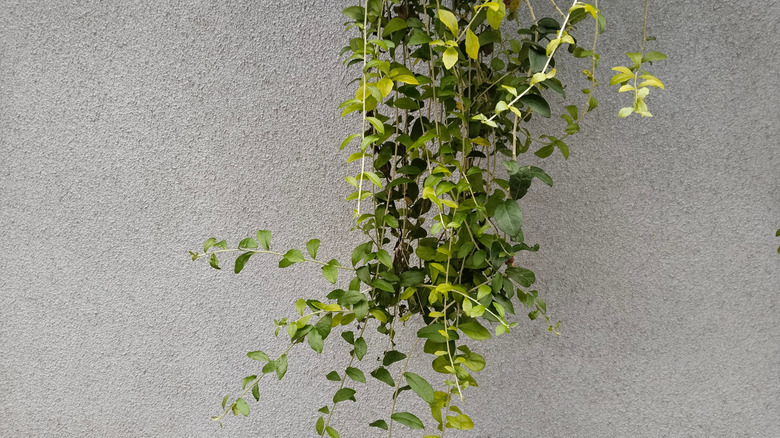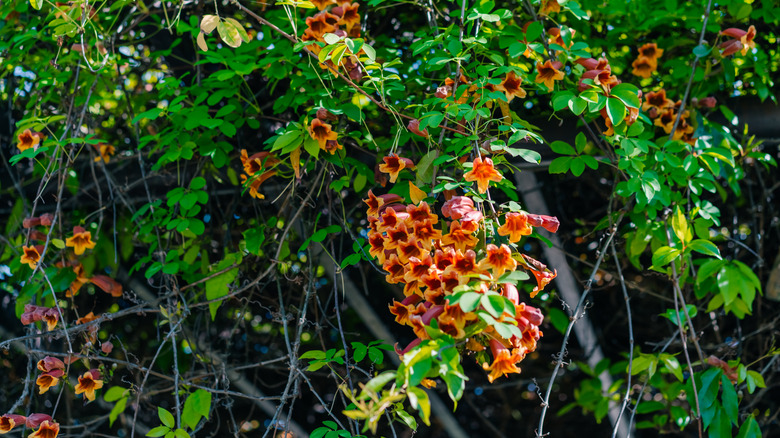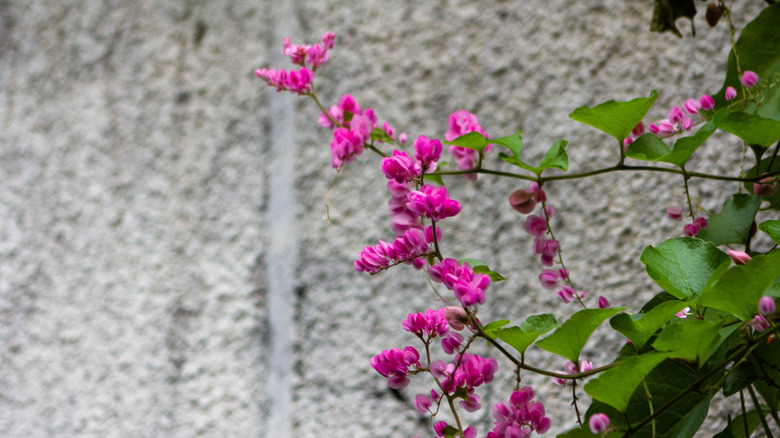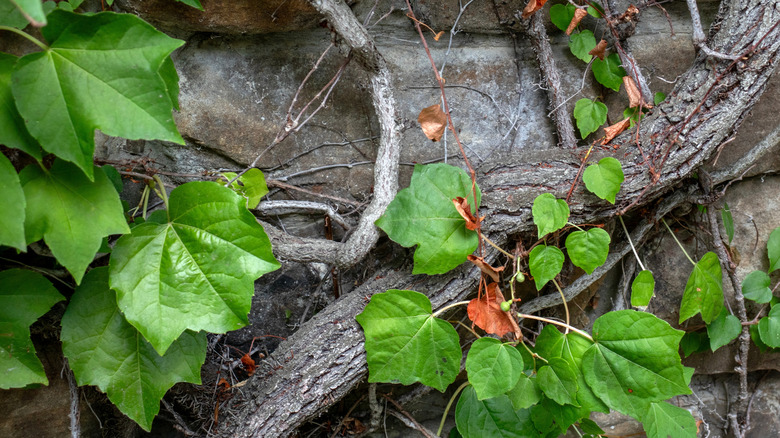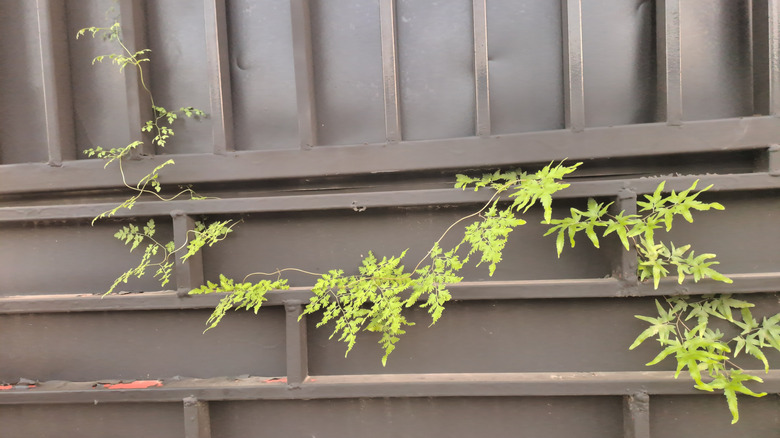13 Climbing Plants You Should Never Grow Along The Side Of Your Home
Climbers and vines are incredibly versatile and useful plants. They're practical and beautiful additions to any landscape. For instance, if you can't grow trees for a natural privacy screen in your yard because it's too small, climbers can take their place. Use them to hide unsightly views, neighboring properties, or create a dense privacy wall. Visually speaking, some vining species produce abundant blooms and can help soften harsh lines of a solid garden structure so it better blends into the surrounding greenery. There is, however, a handful of climbers that grow so vigorously that they can damage your home. Examples include English ivy, Virginia creeper, trumpet vine, creeping fig, oriental bittersweet, and Japanese climbing fern, among others.
Some of these pesky plants cause house siding to rot, while others damage the wood in other ways. Some vines grow into plumbing pipes and gutters, while others become so heavy that they can topple trees — certainly not something you want climbing up the side of your house. Perhaps even worse, some climbers attract wasps and other harmful insects, or conceal the hiding places of health-harming pests like rats or moles that wreak havoc under your lawn or paved patio. If you still want to plant problematic vines near your home (outside of invasive species, of course), consider building a trellis at least a few inches from the wall. That way, even if a climber is too vigorous, it won't pose a risk to your house or nearby structures.
English ivy
English ivy (Hedera helix) is a hardy climbing plant that will grow well pretty much anywhere. It spreads fast, thrives in shade, and has low maintenance requirements. Given these attributes, you might be tempted to plant it, but growing it beside your home is often a bad idea. It can damage mortar, wood, and stucco, spoil painted surfaces, and curl around gutters. If it grows out of control, it can even pull aluminum siding loose. Plus, it is classed as invasive in the U.S., meaning you shouldn't grow it anyway.
Virginia creeper
Virginia creeper (Parthenocissus quinquefolia) is beloved by many gardeners. It has flowers that attract pollinators and brilliant fall color. Don't be fooled by its beauty. Virginia creeper attaches to surfaces using adhesive disks that can damage wiring, shutters, gutters, and paint. Pulling it off won't save whatever it's clinging to, since it leaves a sticky residue behind. Your problems won't end here, either. Sometimes, moisture builds up under its dense growth, which can cause the wall beneath to rot.
Trumpet vine
Trumpet vine (Campsis radicans) is a vigorous, deciduous perennial vine. It has dense growth and showy red flowers that attract hummingbirds, making it a tempting plant to grow. While you can grow it, be sure to plant it well away from the side of your house or other structures because it is highly flammable. It also has thick, woody stems that can invade house siding and destroy it. If you are thinking you are safe because your walls are made of stone or brick, then you are wrong. It can damage those materials, too.
Kudzu vine
Kudzu vine (Pueraria montana var. lobata) has a deep root system, making it hardy enough to survive even periods of drought. It enriches the soil, and its dense growth makes it useful as a cover plant. However, kudzu vine is not recommended for home gardens in the U.S. It is obnoxiously weedy and considered invasive. The vine quickly forms dense mats of growth over anything tall, and its weight can damage these structures over time. One plant's root system can create dozens of vines, which take over everything in their path.
Creeping fig
Creeping fig or climbing fig (Ficus pumila) is a woody climber. You can use it as a beautiful ground cover or as a textural plant on trellises, fences, and walls. However, growing it near your house can cause some trouble. It adheres to porous surfaces, clinging to stucco and paint. Let it grow uncontrollably, and you will need to resurface your walls sooner rather than later, especially on damp surfaces. The vine also attracts fig wasps, which don't sting or cause harm — though you may mind if you're not a fan of bugs.
Chinese wisteria
Chinese Wisteria (Wisteria sinensis) has mildly fragrant, blue-violet flowers that grow in grape-like clusters, creating dramatic displays. But if you plan to plant it next to your home, it's not the right move. It has twining vines, which may not seem like a big issue, but when you consider their weight, the problem becomes clear. The heavy branches can destroy otherwise sturdy wooden and metal structures. They can also grow into gutters and under siding. Despite its pretty bloom, it's considered invasive in the U.S.
Oriental bittersweet
Oriental Bittersweet (Celastrus orbiculatus) is an ornamental, woody, deciduous perennial vine. Its bright, fleshy arils look beautiful in the garden and draw in wildlife. However, you don't want to plant it alongside your home. Its winding tendrils can damage infrastructure like telephone wires and power lines, and the vine can even bring down garden sheds with its weight. It spreads so vigorously that it is considered invasive in the U.S. If all that was not enough, consider that this aggressive vine can cause severe allergic reactions.
Star jasmine
If you dislike rats, don't plant star jasmine (Trachelospermum jasminoides) near your home. Climbers like star jasmine create ideal conditions for roof rat activity and infestation. What's more, this dense vine is considered high-risk for wildfires. While you should skip growing it up the walls of your home, it can be planted elsewhere in the garden. For instance, you can use it as a ground cover or grow it over an arbor. Just be sure to thin it often to keep rats away and the fire risk low, even if it's planted far away from your house.
Wintercreeper
Wintercreeper (Euonymus fortunei), sometimes also called climbing euonymus, is a woody evergreen vine. It is easy to grow and tolerates most soil types, which might make it seem like a good choice for home gardeners seeking a climber. However, it is best avoided because it grows fast and spreads aggressively. It rapidly scales nearby structures and spreads into neighboring garden beds. Plus, the dense thickets it forms trap moisture, causing serious damage to any wall it's growing on. Oh, and did we mention it is considered invasive in the U.S.? This is a vine to avoid.
Crossvine
Crossvine (Bignonia capreolata) is also sometimes called trumpet flower, not to be confused with trumpet vine. It grows quickly and produces reddish-orange flowers with yellow accents in late winter. Not many plants flower in winter, making it an attractive option for gardeners. However, it clings to walls easily using strong adhesive disks. By the time this vine has scaled a wall, it will be next to impossible to remove. It can even loosen mortar between bricks and get under siding, lifting it from the house.
Coral vine
Coral vine (Antigonon leptopus) is another one of the climbing and vining plants to avoid growing in your yard — and especially against your house. Don't be fooled by its pretty common names, like love vine, queen's wreath, and chain of love, or its beautiful pink flowers. It will quickly cover walls and nearby structures with dense stems and foliage, and attracts thrips, flies, wasps, raccoons, and even feral pigs, none of which are particularly desirable near homes. If you live in Florida, you won't be able to plant it anyway; it is classified as invasive in the state.
Boston ivy
What makes Boston ivy (Parthenocissus tricuspidata) desirable in home settings is its attractive three-lobed leaves that turn maroon in the fall. Should you plant it along the side of your home? No — here's why. Boston ivy can damage shutters, strangle wiring, and invade gutters. And that's not all. It can also ruin the paint on your home and creep under shingles. Once it takes hold, it's nearly impossible to remove without damage to the structure. The only solution is to kill the plant by cutting it out at the roots.
Japanese climbing fern
The Japanese climbing fern (Lygodium japonicum) is an eye-catching climber. Its delicate, lace-like fronds more than make up for the plant having no flowers. Despite its attractiveness, planting it against your home is far from a good idea. The plant creates dense mats as it clambers over walls, trees, or the ground, and it also creates a fire ladder, making it a serious safety hazard. If a fire does occur, Japanese climbing fern will quickly grow back from underground rhizomes and start invading your home once again.
